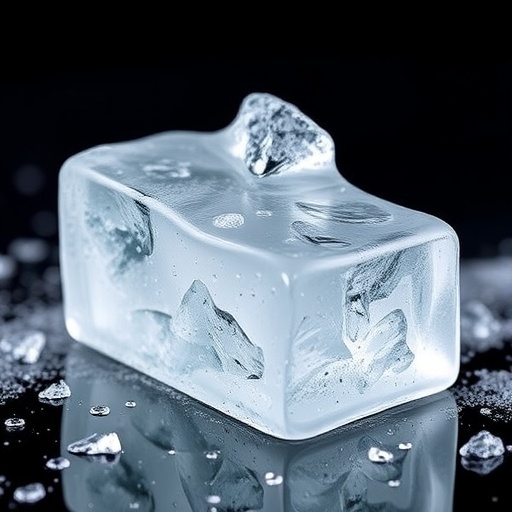In the frozen expanses of the Arctic, a subtle but profound chemical transformation is underway that challenges longstanding assumptions about the inertness of ice. Recent experimental research conducted at Umeå University reveals that ice, rather than merely acting as a static barrier, actively facilitates the dissolution of iron minerals in ways previously unrecognized. This discovery not only deepens our understanding of cryogenic geochemical processes but also bears significant implications for the changing landscape of Arctic ecosystems under the influence of climate warming.
Traditionally, the scientific consensus has held that chemical reactions tend to slow down drastically as temperatures drop below the freezing point, with ice serving mainly as a physical constraint that immobilizes reactants. However, this new study overturns this assumption by demonstrating that ice at -10°C can dissolve iron minerals more efficiently than liquid water at 4°C. This counterintuitive phenomenon arises from the unique microenvironment within freezing ice, where microscopic pockets of liquid water become concentrated chemical reactors, accelerating iron release even at temperatures as frigid as -30°C.
The scientists focused their investigations on goethite, a widespread iron oxyhydroxide mineral common in soils and sediments, exposed to organic acids naturally occurring in permafrost and soil environments. Using advanced microscopy techniques and controlled laboratory experiments, they elucidated the kinetic and mechanistic roles that ice plays during freeze-thaw cycles. Notably, these cycles enhance mineral dissolution by repeatedly liberating organic compounds trapped within the ice matrix, which then fuel subsequent chemical reactions, fostering efficient iron mobilization.
Salinity emerged as a pivotal factor modulating this dissolution process. Freshwater and brackish environments were found to facilitate increased iron release, whereas the presence of seawater tends to inhibit the chemical reactivity. This distinction underscores the complex interplay between ionic strength, pH, and mineral-organic interactions within the partially frozen matrices, painting a nuanced picture of biogeochemical cycling in diverse aquatic systems impacted by seasonal freezing.
The implications of these findings extend well beyond academic curiosity, particularly given the accelerating pace of climate warming in Arctic and alpine regions. As permafrost thaws and freeze-thaw events become more frequent, the mobilization of iron into rivers and groundwater could alter water chemistry and provoke cascading effects on aquatic ecosystems. Iron, an essential micronutrient but potentially toxic in excessive quantities, influences the productivity and species composition of microbial communities, thus shaping broader ecosystem dynamics.
Moreover, the researchers emphasize that the environments affected are primarily acidic, such as those found in mine drainage areas, acid sulfate soils surrounding the Baltic Sea, and frozen dust in the atmosphere. In these contexts, the enhanced dissolution of iron minerals facilitated by ice has the potential to significantly alter element cycling and metal transport. Understanding these processes is vital for predicting the environmental fate of iron and associated contaminants in a warming world.
The study’s findings also challenge the conventional paradigm that ice acts solely as a passive medium preserving materials in stasis. Instead, freezing and thawing are dynamic processes which instigate complex chemical reactions at the mineral-water interface. This realization opens new avenues for exploring the roles that cryogenic physicochemical conditions play in shaping the distribution and bioavailability of trace elements essential to environmental and climatic processes.
Foremost among the mechanisms involved is the creation of ultraconcentrated acidic microdomains within the ice matrix—tiny volumes of unfrozen liquid where organic acids and minerals reach reactive concentrations far exceeding those in bulk liquid water. These microreactors accelerate proton-promoted dissolution reactions, enhancing the breakdown of iron oxyhydroxides. This phenomenon helps explain the surprisingly high rates of chemical weathering and nutrient release observed in frozen soils and sediments.
Researcher Jean-François Boily, a professor at Umeå University and co-author of the study, highlights that ice should no longer be viewed as an inert barrier but as an ‘active player’ in environmental chemistry. The capacity of ice to foster concentrated chemical environments and catalyze mineral dissolution at subzero temperatures provides essential insight into cryospheric geochemistry and its responses to ongoing environmental change.
Angelo Pio Sebaaly, the doctoral student and first author, indicates that the increase in freeze-thaw cycling due to rising global temperatures will lead to pulses of iron released from thawing permafrost and soils into adjacent waterways. This flux may contribute to altered water quality, influencing aquatic food webs, biogeochemical cycles, and ultimately, the health of polar and subpolar ecosystems, highlighting the far-reaching consequences of a warming planet.
Future research, as planned by the Boily laboratory, aims to explore whether similar dissolution dynamics occur across other iron-bearing minerals within ice and to elucidate the broader ecological ramifications. Unraveling these mechanisms will enhance predictive models that incorporate geochemical feedbacks between the cryosphere and biosphere, thus informing mitigation and adaptation strategies for vulnerable Arctic environments.
In summary, this groundbreaking study compels a re-evaluation of the chemical inertness traditionally ascribed to frozen environments. By revealing ice as a kinetic and mechanistic driver of iron oxyhydroxide dissolution, it significantly advances our understanding of elemental cycling under extreme conditions, carrying tremendous implications for environmental chemistry, climate science, and ecosystem resilience amid accelerating environmental change.
Subject of Research: Not applicable
Article Title: Ice as a kinetic and mechanistic driver of oxalate-promoted iron oxyhydroxide dissolution
News Publication Date: 26-Aug-2025
Web References: DOI link
References: Proceedings of the National Academy of Sciences
Image Credits: Jean-François Boily
Keywords
Environmental chemistry; Earth sciences; Hydrogeochemistry; Biogeochemistry; Chemistry; Ice melt; Water; Permafrost; Arctic ice; Geochemistry; Climate change




